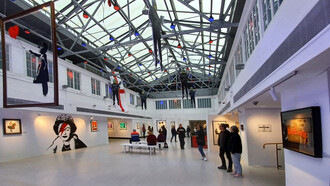The recent monographic exhibition dedicated to Olmo Amato at Palazzo Ferrero in Biella gave us the opportunity to discover how his stunning photographic works are created. Images capable of uniting apparently distant universes, merging into a harmonious unicum of rare lyrical intensity.
After Rinascite, it is the turn of La luna e il bambù (The moon and the bamboo), the result of his encounter with the Japanese culture, using photomontages in which he mixes landscapes and archive images, subsequently printing them on traditional washi paper, which is well suited to modern photographic printing technology.
Amato has a preference for uncontaminated environments, which give him the freedom to experiment with the protagonists of his images at a later date, faithful to his personal vision of the completed work.
A photographer and filmmaker since 2010, he works in fine art printing, post-production and teaching. In 2018 he won the Setup award as best artist under 35, in 2019 the Campolmi award and the Malamegi Lab award.
May I ask you about the genesis of your newest work?
The whole project consists of works mounted on Japanese paper and an immersive installation which was not possible in Biella but was previously presented in Rome.
I am married to a Japanese person who brought me closer to the East. It was an unexpected discovery and this often happens with my work, as I never know what will come out of it, I follow my intuition and put all pieces together. Then, almost magically, everything takes a coherent form. Every time I approach my photographic work I do it with the curiosity of travel discovery. Back home, I do something else instead, and I explore other dimensions with my PCs. I photograph landscapes in places isolated from man. Rarefied places, with minimal human presence, without their traces, as I like to distance myself from humanity.
I don't have clear ideas about the places I shoot at the beginning and I just collect them (sometimes for years). One thing I understood is that the shots that really work are those where I notice that a specific place conceals a mystery, something I cannot grasp. I have picked up clues I can’t immediately understand.
The first step deals with collecting. I have always worked with archive material that has already been digitalised in terms of its provenance and quantity, and for a period of time, I just work on that.
The interesting thing is when I start playing with the images (the playful aspect is fundamental): combining distant aspects means exploring. The main element is to notice the changes when I decontextualise characters from their environment and insert them into mine. It becomes an almost mystical, fairy tale moment.
I like to create stories, leaving interpretation and narration open. I don't tell more than I need to. Very often the result is unexpected, I deliberately don't work with posed actors, because I don't like building images at the table, I don't find it funny, there is not the same element of surprise brought by two images from different moments, which you feel are made for each other, as if they were just waiting to find one another.
Is it difficult to find what you are attracted to?
I find myself on a balance, as one part of my work is extremely analytical, I want to have everything under control while, on the other hand, I am extremely emotional. I need both a rational and an unconscious perspective. I don't study the images, I feel them.
I can't build everything up on a table, also because sometimes the material takes unexpected paths. I like this feeling of having to leave a door open to chaos, as this is the only way I can express myself completely.
I use vintage photos because the constraint of not having everything fit together, of having fewer possibilities with subjects and places makes you more creative in finding a solution using what you have.
Only some of them are made to be with each other and that's the poetry in the process, just like two lovers. In Rinascite, my first work, I chose dead people and change their environment to make them become something else, almost metaphysical representations. This is the principle of my photographic works.
You depicted Northern and Japanese worlds. What were the challenges?
Japan was a wonderful experience, especially in the forests. I chose natural, intimate places with bamboo trees. It is a very regular plant with a peculiar structure, high, with a rhythm within its depth and height. It is fundamental to Japanese culture, as it needs to be cared for, otherwise it invades everything.
The story of the Shining Princess was a huge source of inspiration, as well as the Yokohama School and Felice Beato. They created highly constructed and posed images, with fake backdrops, shot in studio. They are hand-coloured black and white images.
Whereas, when I created the first photomontages and noticed how going back to black and white meant these figures looked less fake, more natural. I brought them back to a familiar space: the Japanese forest, in natural poses, in places of reflection.















